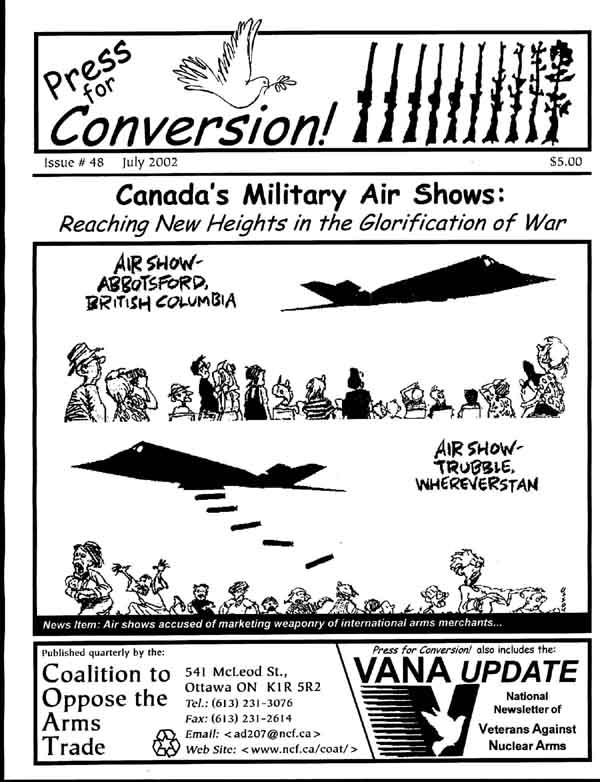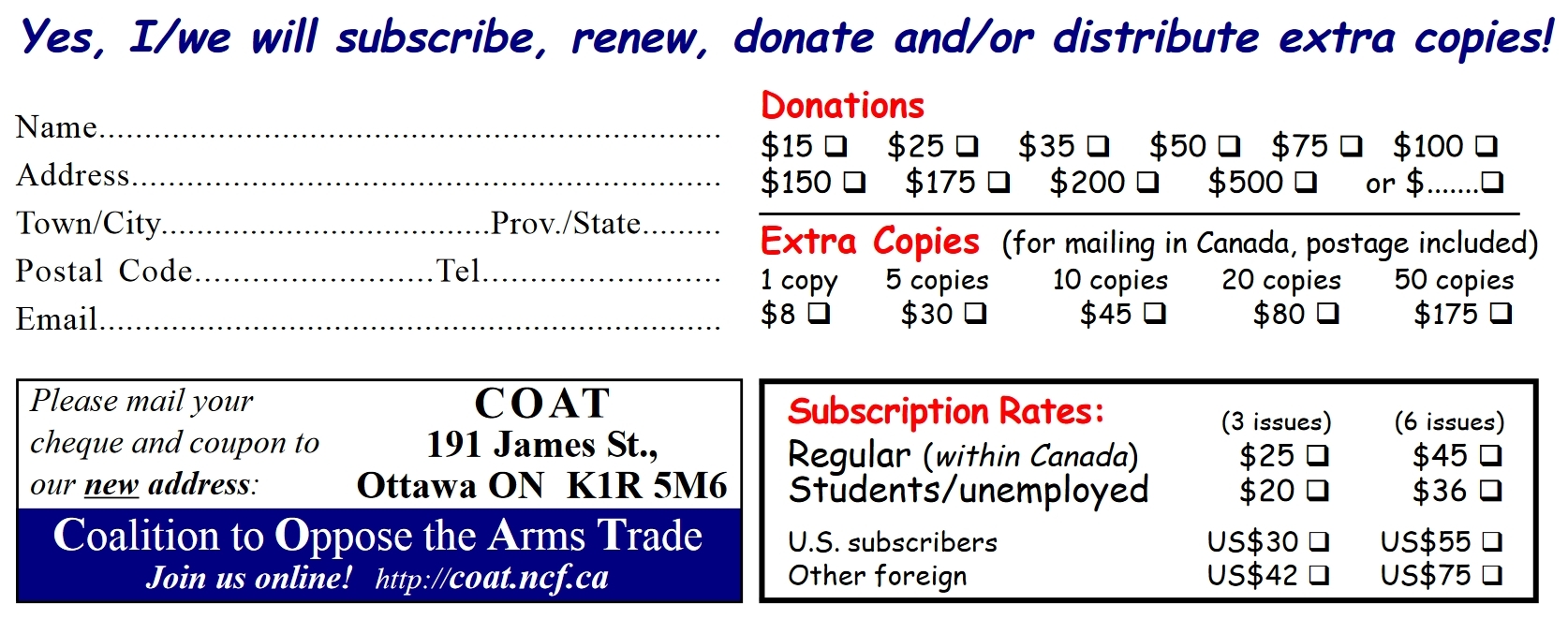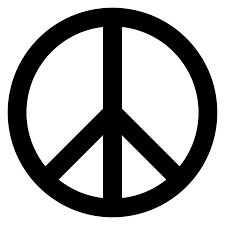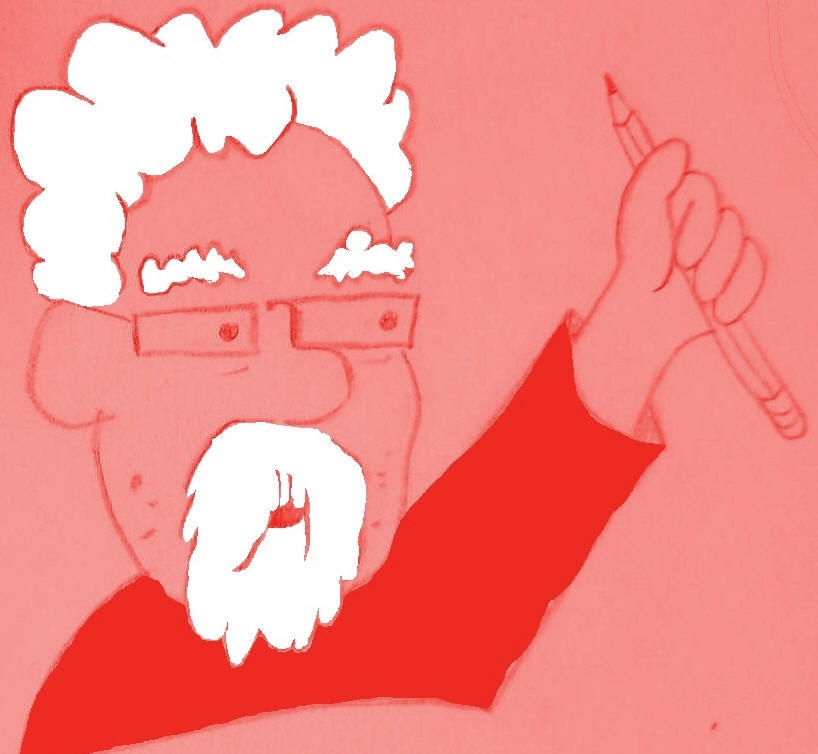 OAT's
first campaign was against ARMX '89, a huge biennial military exhibition, with
about 450 exhibiting companies. This
campaign marked the first time in Canadian history that the peace movement had
organized a large protest effort against a weapons bazaar. OAT's
first campaign was against ARMX '89, a huge biennial military exhibition, with
about 450 exhibiting companies. This
campaign marked the first time in Canadian history that the peace movement had
organized a large protest effort against a weapons bazaar.
COAT's initial efforts were a great success. Not only
did we mobilize scores of peace, development, human rights and church groups to
spread the word and to take action, our campaign inspired the federal NDP to
initiate a full-day debate in the House of Commons on ARMX. COAT's campaign also
sparked many hundreds of mainstream newspapers, magazines, radio and TV news
programs, and a host of grass-roots and community media outlets, progressive
newsletters and other publications, to cover the issue. For the first time,
millions heard something about Canada's role in the arms trade.
Our work also led to an effort at Ottawa City Hall, to get councillors to pass a
strongly-worded bylaw (six weeks before ARMX '89) to ban all subsequent arms
bazaars from city property.
When Baxter Publishing, which organized ARMX, was
forced away from all City-of-Ottawa facilities after 1989, it was sent
scrambling to find a new venue. The best they could do was schedule the
show's return
to the village of Carp, almost 40 kilometres from Parliament Hill.
However, when Mulroney's Progressive Conservative government decided to join the
US-led war against Iraq, ARMX '91 organizers cancelled their military trade show.
This decision prevented the
potential for a new wave of even worse PR than they had endured during the 1989 campaign. The heightened scrutiny and criticism that arms producers would
have faced while flogging their deadly wares to government buyers and military
users, during that controversial Middle East war, was something they had to
avoid.
When ARMX reared its head again in 1993, it had cleverly rebranded
itself "Peacekeeping." Still banned from City |
property, the arms show found a home for
itself at the provincial-government's downtown Ottawa Congress Centre. Despite
much protest, COAT efforts to get Bob Rae's Ontario NDP government to stop that
military expo, fell on deaf ears. After their 1993 show, organizers
decided to downscale their event to a conference and move it to Washington
DC, where it then fizzled out never to be seen again.
1993 also saw the appearance of other the HiTec and National Security
trade events that COAT also opposed. The following year we also contested
the "Hunting" gun show with its 650 dealers from the "Sporting Arms
and Ammunition Association." They flogged their wares
to local police, the RCMP, armed forces and many embassies from around the
world (except those allied with the USSR) who were all invited by
organizers to attend.
This demise of ARMX (and its clone "Peacekeeping") left a vacuum but for several
years nothing arose to take its place. In 1997 a relatively small private
military-trade expo was held at the National Capital Air Show (NCAS). COAT
mounted a campaign to oppose the targeting of children and youth at this
huge, City-sponsored event. We opposed the blatant
glorification of warplanes at this air show, and protested its trade show
component. Our efforts continued in 1998 when the heavily-militarised air show
returned with its trade show component. The NCAS's trade event, called
Aerospace/High-tech/Industrial show only lasted those two years further
shows were cancelled.
1998 was also the year that the CANSEC appeared. This arms bazaar, with a mere 52
exhibiting companies, was only about a tenth the size of ARMX '89. As such it
easily fit
inside the province's Congress Centre downtown.
After steady organizing against Ottawa arms shows throughout most of the
1990s, COAT took a back seat with these efforts the early 2000s and
focused on other things. However, in 2008, when COAT learned that three military expos (under the banner 'Secure Canada')
were destined to return to Ottawa City property, we took the lead in
opposing them, preparing many resorces, calling meetings and starting a
petition that collected thousands of signatures.
When these three arms shows were cancelled, they blamed protesters.
Unfortunately COAT's efforts to stop
City Council
from ending its 20-year ban were unsuccessful. To Ottawa's great shame,
City Council allowed arms shows back onto
city property.
CANSEC has now moved to the EY Centre, a much bigger, privately-owned facility
near the airport. The struggle continues! |
|
"ARMX 89"
(Organized by Baxter Publishing)
Personal
reflections on ARMX 1989 by Richard Sanders
(Trials &
Tribulations of a Stressfully Successful anti-Arms Trade Campaign)
ARMX:
Canada's International Arms Exhibition by Richard Sanders
This is a 12-page COAT booklet published in 1990. It details
the history of ARMX from its start as a Government of Canada-organized military
trade show in 1983 and 1985, to its privatization and growth in 1987 and 1989.
COAT Newsletter, September 1989 by Richard Sanders
This COAT newsletter exposed plans for an arms industry front
group that was spawned at ARMX 89. It also has details on the history of COAT's
formation as well as information on a Public Inquiry into ARMX organized by COAT
in 1989
ARMX '89 and the Coalition to Oppose the Arms Trade by Richard Sanders
Peace Magazine, April/May 1989, p.15

145 mainstream news clips about ARMX from 1989
(source: Richard Sanders'
collection of clippings from newspapers.com)
Note: A civil disobedience campaign
to block the gates of ARMX '89 on May 23, was initiated by the Alliance for
Nonviolent Action (ANVA). About 145 were arrested, including my mom and I.
(I was active in organizing various ANVA actions for about four years before initiating COAT's
formation in 1988.) About 20% of the news clips
on ARMX focused on the ANVA's action. ANVA activists from across Ontario and
in Quebec were active in promoting COAT's May 22 rally. ANVA's proposal that
COAT's endorse their nonviolent May-23 blockade of ARMX was
strongly opposed by some within COAT. For example, the representative for Project
Ploughshares National, stood up at COAT's meeting to declare that it would withdraw from COAT if it endorsed ANVA's
peaceful action. As a result, ANVA's action was not endorsed by COAT. An ANVA speaker did however speak at COAT's rally and did
urge activists to support the next day's action. (For several years prior to
ARMX, the key COAT activists in Ottawa, such as Richard, Sylvia and Roy Sanders,
and Christine Keess, had all been very active participants in ANVA and we obviously wanted
COAT to endorse ANVA's peaceful blockade of ARMX's gates.)
"ARMX 91"
(cancelled)
(Organized by Baxter Publishing)
Theme: "Training for Peace: Defence Technology of the Future"
Five short articles by Richard Sanders:
West Carleton Citizens fight ARMX
Peace and Environment News, September 1990
"Peacekeeping 93"
(Organized by Baxter Publishing)
Two short articles by Richard
Sanders:
PEACEX '93 to Counter the Return of ARMX
Peace and Environment News,
March 1993
ARMX Leaves; DisARMX Broadens Focus
Peace and Environment News,
September 1993

11
mainstream news clips about Peacekeeping 1993
(source: Richard Sanders' collection of clippings from newspapers.com)
"Peacekeeping 95":
Downscaled to a conference, moved to the US, and then disappeared
The organizer of ARMX 89, the cancelled ARMX 91 and Peacekeeping 93 was Baxter
Publishing. In 1995 they downscaled their arms trade event to a conference and
moved it to the US. It was called The International Peacekeeping '95 conference.
It was sponsored by Baxter Publishing, the Canadian Institute of Strategic
Studies and the Lester Pearson Peacekeeping Training Center.
After that it seems to have completely disappeared. It is mentioned in
this source:
Star Tribune, Minneapolis, Minnesota, 12 Nov
1995, Sun • Page 20
"HiTec 1993"
(Organized by the Department of External
Affairs)
In late February 1993, Canada's Department of
External Affairs held its three-day HiTec exhibition at the Ontario-government's
Ottawa Congress Centre. This trade exposition brought fifty-two trade
commissioners to Ottawa from around the world. These government-paid promoters
of Canadian products are stationed in Canadian High Commissions abroad. Their
purpose in coming to Ottawa was to meet with representatives of corporations
whose goal was to expand the export sales of their Canadian high-tech product.
By learning about these products from company officials, Trade Commissioners
were better able to help them sell their wares to foreign buyers.
These high-tech products promoted at HiTec 93 included those useful to foreign
militaries. A large percent of Canadian military exports are high tech products
and components for major weapons systems. When the Trade Commissioners returned
to their diplomatic stations abroad, they were equipped with information and
resources from HiTeC 93 to assist them in promoting the export of high-tech,
Canadian products -- including military products -- to those foreign countries.
As the Ottawa Citizen article below noted:
"Among the Canadian trade commissioners attending HITEC '93 are those based in
China, Iran, Thailand, Chile and Colombia, according to a list obtained by
Sanders.... [H]e said. 'This is worse than Peacekeeping '93 because this
has direct support from the government.'"
The article goes on to state that:
"[S]how spokeswoman Gisele Laframboise said defence [sic] equipment, isn't being
displayed at HITEC '93. Laframboise said over the years the exhibition has
changed, moving away from exclusively promoting defence equipment to
dealing as well with electronics, aerospace, computer software and
environmental products. Sanders said the peace coalition has just started a
campaign to boycott the congress centre. It is approaching groups who might use
the centre and asking them not to book functions there, he said." (Emphasis
added.)

Peace group at war with
defence show
By David Pugliese
The Ottawa Citizen, 27 Feb 1993, p.20
"National Security 1993"
(Organized by the Canadian Defence Preparedness
Association)
The Canadian Defence Preparedness Association (CDPA)
held its "National Security '93" military trade show at the
Ottawa Congress Centre (OCC) on November 30 and
December 1.
The OCC, an Ontario government facility, refused to join
the City of Ottawa's 1989 ban on hosting military exhibitions on municipal
property. The Coalition to Oppose the
Arms Trade encouraged organizations to boycott the OCC until it
banned all military trade events from its premises.
National Security '93
National Security '93 includes the annual general meeting
of the CDPA, seminars, and an exhibition of military hardware.
In 1983, during the dark days of the Cold War, the CDPA
was formed as a chapter of the American Defense Preparedness Association.
Although later re-incorporated as an independent Canadian association in 1987,
it still retains close ties with its parent organization. The core of the CDPA's
membership is comprised of some of Canada's largest military companies. The
CDPA's prime objective is to promote the vested interests of these corporate
members.
The CDPA has intimate working relationships with numerous
federal government departments. It has signed official "memorandums of
understanding" with the Department of National Defence, Supply and Services
Canada, and Industry, Science and Technology Canada. According to a CDPA fact
sheet, CDPA representatives are "well received" by government officials when
representing the association's "concerns and issues."
About 100 military companies will exhibit hardware to "a
targeted audience of government departments, research institutions and selected
foreign missions," according to the National Security '93 Exhibitor's
Information Kit
Embassy officials from NATO, Australia and
New Zealand were invited. Spokesperson for the event was Ed Healey, a former
Admiral.
Read more here:
COAT Flags Fall Military Shows
Peace and Environment News,
November 1993

Peace
activists say Congress Centre Trade shows
really arms markets
Ottawa Citizen, November 26, 1993
"Canadian Hunting Trade Show 1994"
(Organized by the Canadian Sporting Arms and Ammunition
Association)
by Richard
Sanders
Although this trade fair was aimed primarily at
selling guns, ammunition and related products to hunters, the organizers
of this event always invited foreign diplomats from
"many embassies." Selling their guns and other wares to the 3,000
attendees of this gun show where "650 dealers."(1)
Also attending the gun trade show were "many delegates
... from local police, the RCMP or the military,"(2)
said Rene Roberge, the executive director of the
Canadian Sporting Arms and Ammunition Association, which was behind this trade
exhibition.
"The guns on display are from manufacturers around the world"(3) said
Roberge, the show's organizer.
Roberge also told the Ottawa Citizen that "We sell
firearms and ammunition... Primarily, it's (aimed at) hunting and shooting
sports, but we do service the (law) enforcement agencies and the military."
(4)
The Ottawa Citizen also reported that:
"Roberge said many embassies were invited to the
hunting show, but the list was screened." (5)
COAT convinced Ottawa City Council
to review its exemption to the Hunting Show. This exemption would allow the show
to go ahead without any further scrutiny until 2005.
This was despite the 1989 City Council resolution banning all weapons-related
trade shows from being held on municipal property. This exemption meant that the
show could potentially become even more open to allowing foreign government
buyers.
Roberge told the Ottawa Citizen that their
invitations to embassies
were "screened to eliminate countries like Bosnia,
Serbia and Somalia."(6)
But this begs the question, why would this gun show's
organizers bother to screen the representatives from different countries if they
really believed that their guns and ammunition would only be used for hunting?
Clearly, they knew that the
embassies were sending representatives to peruse the gun show for the
purpose of buying products for their governments. This meant that
inviting embassy personnel was a way for the show to expand its markets by
promoting sales of its 650 dealers to foreign governments in the market to
buy their products.
Upon touring this gun show in February 1994, councillors Diane Holmes and
Alex Cullen, recommended to Council that the show be allowed a 10-year
exemption. Holmes and Cullen had led opposition to ARMX within Ottawa City
Hall in 1989. However, they did not support COAT's contention that giving
this weapons show a 10-year exemption would contravene the bylaw banning
events promoting the sale and export of guns.
The Ottawa Citizen noted that Holmes wanted to "add a clause [to the
exemption] that makes it clear that it is prohibited from becoming a
military show."(7)
Holmes also noted that "I don't think the animals stand much of a chance,"
and Cullen remarked that "if I were a deer I would fear for genocide."(8)
Sources:
1.
Ottawa Citizen, Nov.
26, 1993
2. Ibid.
3. Ottawa Citizen,
March 20, 1994
4.
Ottawa Citizen, Nov.
26, 1993
5. Ibid.
6.
Ottawa Citizen, Dec. 2
1993
7. Ottawa Citizen March
20, 1994
8. Ibid.
Read more in these Articles:
Hunting Show or Weapons Bazaar? City Bylaw to Decide
by Richard
Sanders
Peace and Environment News,
February 1994

3
mainstream news clips about COAT's work against the Hunting Show (1994)
(source: Richard
Sanders' collection of clippings from newspapers.com)
"Aerospace/High-tech/Industrial Show 1997 and 1998"
(Organized by the National Capital Air Show)
Between 1997 and 2002, COAT organized protests and educational
campaigns to oppose militarized air shows in Canada. Being Ottawa-based,
we began by focusing on the National Capital Air Show (NCAS). We also
produced information for peace groups across Canada and encouraged
supportive activists and organizations to protest local air shows in their
cities and several did.
(Learn more about those
COAT campaigns here.)
In 1997 and
1998, the NCAS organized an international military/aerospace trade show as
part of its "air show." It had this unwieldy, long-winded
official title" "The Aerospace/High-technology/Industrial Trade Show"
(Let's call it AHTI for short.) The venue for AHTI was the
former Uplands Air Force Base—an airport facility next to the Ottawa
International Airport. CFB Uplands -- which closed in 1994 -- had been the
location of ARMX in 1985, when it was still a functioning air force base.
This former military base is across the road from the EY Centre where
CANSEC is now held.)
In 1998, the NCAS second and last annual military trade show (AHTI) was timed to coincide with a
CONJEFAMER—a major conference hosted by the federal government at its
Conference Centre in the old downtown train station across from the
Chateau Laurier Hotel. (CONJEFAMER is the Spanish acronym for
Conference of Chiefs of the American Air Forces).
This conference brought together the Air Force Generals from 22 countries
in South, Central and North America. COAT organized an education campaign
and protest against CONJEFAMER, the Air Show and its military trade show
Read more about CONJEFAMER and the NCAS
military/aerospace
trade show here:
"Latin American Generals in Ottawa!" by Richard Sanders
Activists to Make Air Show a Peace Issue
Peace and Environment News,
May-June 1998
Talking Peace, Selling War
Peace and Environment News,
March 1998
Activists to Protest Military Side of Air Show
Peace and Environment News,
May-June 1997
Peace Tour Planned for Air Show
Peace and Environment News,
March 1997

#48 (July 2002):
Canada's Military Air Shows:
Reaching New Heights in the Glorification of War

17 mainstream news clips about COAT's work against Air Shows (1997 - 2002)
(source:
Richard Sanders' collection of clippings from newspapers.com)
"Secure
Canada, TechNet North and
Unmanned Systems Canada Expo"
(cancelled)
(Secure Canada: Organized by the
US Embassy, the US Commercial
Service and the British High Commission in Ottawa)
(TechNet North: Organized by Cdn. & Ottawa chapters, US-led international Armed Forces Communications
& Electronics Assoc.)
(Unmanned
Systems Canada Expo: Organized by the Cdn.
affiliate of the
Association for
Unmanned Vehicle Systems International )
Upon learning in July 2008 that three military trade shows were scheduled to
take place at the City of Ottawa's prime exhibition facility at Lansdowne Park
(Sept. 30 - Oct.1, 2008), COAT immediately initiated opposition to the event.
Holding these arms bazaars would have meant the end of the City's 20-year ban
prohibiting all military trade shows from being hosted on municipal property.
Opposition was launched by COAT with
emails sent to many thousands of
supporters from the previous 20 years of anti-arms trade work . One tool
created by COAT was an online petition to Ottawa City Council. This new petition
to uphold the City's 20-year ban eventually garnered 5000 ? signatures.
(Hundreds of signatures were also collected on paper petitions created by COAT.)
"Secure
Canada" was supposed to have included three distinct arms exhibitions
rolled into one. Or, in the jargon-filled words of event organizers,
"Secure
Canada 2008" was going to be "an exciting new horizontal event showcasing
three complimentary security segments in one continuous event."
Each part of this weapons
extravaganza was planned to have its own parallel events, such as
meetings, briefing sessions, panel discussions, keynote speakers, tours
and/or receptions and fundraising dinners.
The
three cancelled Military-Trade Shows:
(1)
Secure Canada
and the World
(39 display booths)
The event was promoted as
"A Showcase of Domestic and International Suppliers in Security,
Public Safety and Defence"
Includes the
U.S. Embassy Defense & Security
Exhibition
and the
UK Trade and Investment Pavilion.
(2)
TechNet
North 2008
(72 display booths)
The
theme was going to be on: "National Security in a Coalition Environment"
"Canada's Premier C4ISR* Exhibition and Professional Development Conference"
* C4ISR =
Command,
Control, Communications, Computers, Intelligence, Surveillance and
Reconnaissance
(3)
The
Unmanned Systems Canada Expo
2008
(49 display booths)
Advertising for the event called it "Canada’s National Showcase for Unmanned
Systems Technologies"
It was tooted in advance
as "Canada’s premier event focusing on
the national and international ground, air and maritime unmanned systems
marketplace."
Who or What was behind "Secure
Canada 2008"?
It was sponsored by the
U.S. embassy and U.S. government's Commerce Department, the U.S.
Chamber of Commerce in Canada, large U.S.
war-related industries and the U.S. business association that represents
the interests of the U.S. Military-Industrial-Academic Complex. And, its
main organizer is a former employee of the U.S. embassy. More on
Who was Sponsoring "Secure
Canada"?
An annotated list
of known Exhibitors
The
"Partial Exhibitor List"
of about 60 exhibitors—that will be showcasing their largely, military wares at
this year's event—reads
like a who's who of the Military Industrial Complex.
U.S. Embassy Arms Bazaar in
Ottawa this fall contravenes City Council Motion of 1989
Some Correspondence
with City Staff
Letter from City Staff
saying that "Secure Canada 2008" is not an arms exhibition (July 21,
2008)
Letter to City Staff
debunking their bogus assertions from Richard Sanders, coordinator,
COAT (July 30, 2008)
City Staff Memo on these
military trade shows (August 27, 2008)
Open Letter to
Mayor OBrien from Richard Sanders, coordinator, COAT (August 27, 2008)
Clive Doucet's formal
questions to City Staff (August 28, 2008) (Includes their reply,
September 9, 2008)
City Staff Memos (September 29, 2008) (includes attached Memo, August
19, 2008)
"Secure Canada 2008" has been cancelled!
However, our struggle continues!

8 mainstream news clips about "Secure Canada 2008" events
(source: Richard
Sanders' collection of clippings from newspapers.com)
More mainstream articles
relating to "Secure Canada 2008"
"CANSEC"
(Organized by the Canadian Defence Industry Association, and then later by
the Canadian
Association of
Defence and Security Industries)
Held at the Ontario-government owned Ottawa Congress Centre (OCC)
from 1998 to 2007. This downtown venue was exempt from the Ottawa-City bylaw
that prohibited all arms show held on municipal property.
In 2007, renovations began on the OCC and the construction there meant that all
trade shows and other events previously held at this facility had to be moved to other venues.
This is why CANSEC organizers then wanted to move to the City of Ottawa's prime venue, the
exhibition grounds at Lansdowne Park in the Glebe neighbourhood.
 Press
for Conversion! Press
for Conversion!
#64 (November 2009):
"CANSEC:
War is Business"
This 50-page issue on Canadian government and
corporate complicity in the lucrative business of war, includes articles, tables
and charts on:
* CANSEC, Canada's top arms bazaar
* Recent Canadian military exports fuelled 62 countries at war
* Canadian war
industries aid and abet Israel's bombing of Gaza
* Canada Pension Plan investments in top
global war industries
* Canadian parts/services for major weapons
used in Iraq.
* War-related exports of Ottawa Mayor's
Calian Technologies

51 mainstream news clips about CANSEC (2003 - 2011)
(source: Richard Sanders'
collection of clippings from newspapers.com)
Note about Mainstream
Media Coverage:
Most (75%) of the print coverage about CANSEC in the 51 clippings from newspaper.com appeared
in 2008, 2009 and 2010 when COAT was most involved: 2003 (2 clips);
2005 (3 clips); 2006 (3 clips); 2007 (3 clips); 2008 (8 clips); 2009 (21 clips);
2010 (9 clips); 2011 (2 clips).
War Shows un-banned as anti-war posters banned
The Leveller, November 27, 2010, p.11
COVID-19 takes down Canada's Top Arms Trade Show!
CANSEC 2020 in Ottawa is Cancelled, of course....
COAT, March 31, 2020.
 
Or, of you want to use the good,
old-fashioned postal method ("snail mail")
just click the coupon below, then print it and mail it with a cheque.
Thanks

|
 ver
the decades, the Coalition to Oppose the Arms Trade (COAT)
ver
the decades, the Coalition to Oppose the Arms Trade (COAT)
 OAT's
first campaign was against ARMX '89, a huge biennial military exhibition, with
about 450 exhibiting companies. This
campaign marked the first time in Canadian history that the peace movement had
organized a large protest effort against a weapons bazaar.
OAT's
first campaign was against ARMX '89, a huge biennial military exhibition, with
about 450 exhibiting companies. This
campaign marked the first time in Canadian history that the peace movement had
organized a large protest effort against a weapons bazaar. 
